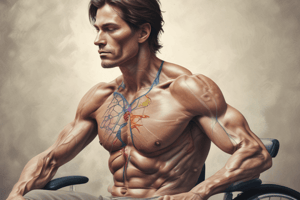Podcast
Questions and Answers
What is a typical early sign of Duchenne Muscular Dystrophy in boys?
What is a typical early sign of Duchenne Muscular Dystrophy in boys?
- Advanced motor skills
- Rapid muscle development
- Awkward gait and difficulty running (correct)
- Inability to stand
Which of the following is a common physical examination finding in boys with Duchenne Muscular Dystrophy?
Which of the following is a common physical examination finding in boys with Duchenne Muscular Dystrophy?
- Normal muscle tone
- Hypotonia of calf muscles
- Atrophy
- Firm calf muscles (pseudo-hypertrophy) (correct)
What is the Gower sign, commonly observed in children with Duchenne Muscular Dystrophy?
What is the Gower sign, commonly observed in children with Duchenne Muscular Dystrophy?
- Ability to rise easily from the ground
- Inability to arise from the ground easily (correct)
- Inability to walk on their toes
- Normal reflexes
What is a common laboratory finding used in the diagnosis of Duchenne Muscular Dystrophy?
What is a common laboratory finding used in the diagnosis of Duchenne Muscular Dystrophy?
Which of these is part of the supportive treatment for Duchenne Muscular Dystrophy?
Which of these is part of the supportive treatment for Duchenne Muscular Dystrophy?
Flashcards
Duchenne Muscular Dystrophy
Duchenne Muscular Dystrophy
X-linked genetic disorder primarily affecting boys, characterized by progressive muscle weakness and degeneration.
Pseudo-hypertrophy (Calf Muscles)
Pseudo-hypertrophy (Calf Muscles)
Enlargement of the calf muscles due to fatty and connective tissue infiltration, not true muscle growth, common in Duchenne Muscular Dystrophy.
Gower Sign
Gower Sign
A diagnostic sign where a child uses their hands and arms to 'walk' up their own body from a squatting position due to proximal muscle weakness.
Creatine Phosphokinase (CPK)
Creatine Phosphokinase (CPK)
Signup and view all the flashcards
DMD Specific Treatments
DMD Specific Treatments
Signup and view all the flashcards
Study Notes
- Duchenne Muscular Dystrophy is an X-linked condition primarily affecting boys.
Clinical Presentation
- Symptoms manifest around 2 to 3 years of age.
- Initial signs include delayed motor milestones and difficulty running.
- Gait is awkward.
Examination Findings
- Patients exhibit tip-toeing.
- Hyperlordosis is observed.
- Gait is waddling.
- Calf muscles are firm due to pseudo-hypertrophy.
- Mild to moderate proximal leg weakness is present.
- Gower's sign is positive, indicating difficulty rising from the floor.
- Arm weakness develops by age six.
- Wheelchair assistance is typically needed by age twelve.
- Respiratory issues arise around age sixteen.
- Death usually occurs due to pneumonia or congestive heart failure.
Investigations
- Serum creatine phosphokinase levels are elevated.
- Muscle biopsy reveals muscle fiber degeneration.
- Prenatal diagnosis is achievable through genetic testing.
Treatment
- Management is largely supportive.
- Bracing can provide support.
- Physical therapy helps maintain function.
- Proper wheelchair fitting is important.
- Scoliosis prevention is necessary.
- A multidisciplinary approach is essential.
- Prednisolone at 0.75 mg/kg/day can be used.
- Golodirsen (Vyondys 53) is a treatment option.
- Deflazacort is another medication used in management.
Studying That Suits You
Use AI to generate personalized quizzes and flashcards to suit your learning preferences.




